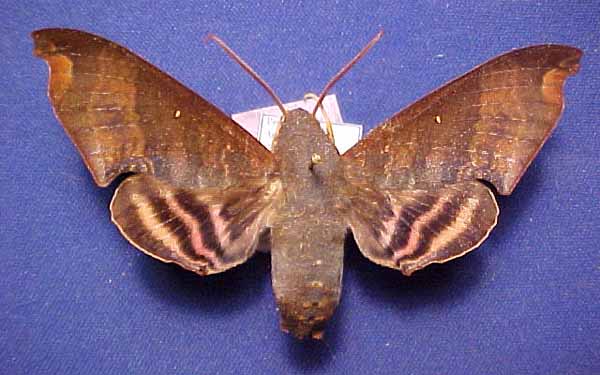Pachygonidia martini
Pachygonidia martini
pah-kih-geh-NIHD-ee-uhmm
MAR-tin-eye
(Gehlen, 1943) Pachygonia

Pachygonidia hopfferi, more likely martini, courtesy of John Vriesi.

Pachygonidia martini, CATE, on my home computer only.
This site has been created by
Bill Oehlke at oehlkew@islandtelecom.com
Comments, suggestions and/or additional information are welcomed by Bill.
TAXONOMY:
Family: Sphingidae, Latreille, 1802
Subfamily: Macroglossinae, Harris, 1839
Tribe: Dilophonotini, Burmeister, 1878
Genus: Pachygonidia Fletcher, 1982 ...........
Species: martini (Gehlen, 1943)
|
MIDI MUSIC
.....It's a Wonderful World.....
copyright C. Odenkirk
ON.OFF
<bgsound src="world.mid" LOOP=FOREVER>
|
DISTRIBUTION:
Pachygonidia martini,
(wingspan: mm, males probably smaller than females), flies in
South America. It has been recorded in
Colombia;
Ecuador: Zamora;
Peru: Huancabamba: Cerro de Pasco; and
Bolivia:
La Paz: Murillo, Río Zongo, 750m; Río Songo [Zongo].
Pachygonidia martini is very similar to Pachygonidia hopfferi, but the forewing outer edge of martini is
rounded at the end of M2, not angulate as in hoppferi.
In martini the outer edge of the dark postmedian band is wavy or toothed, whereas in hoppferi it is very smooth and straight.
CATE
Pachygonidia martini and P. hopfferi
"can be easily separated by the form of the outer edge of the
postmedian transverse band on the forewing. In P. martini
it is wavy, whereas in P. hopfferi it is straight. The
specimen illustrated by d'Abrera ([1987]: 109) as P. hopfferi
is P. martini." Haxaire.
Also the forewing outer edge of P. martini is rounded at the end of M2 (not angulate).
FLIGHT TIMES:
There are probably several flights
throughout the year.
ECLOSION:
Larvae probably pupate in thin walled cocoons
under leaf litter.
SCENTING AND MATING:
Females call in the males with a
pheromone released from a gland at the tip of the abdomen.
EGGS, LARVAE, PUPAE:
Mature larvae probably descend
host to pupate amongst leaf litter. Larvae probably feed on Doliocarpus
dentatus, Doliocarpus multiflorus and Tetracera hydrophila
.
Use your browser "Back" button to return to the previous page.
Return to U. S. A. Table
Return to Sphingidae Index
Return to Dilophonotini Tribe

